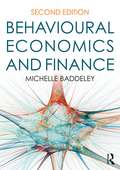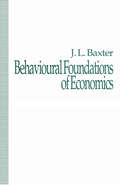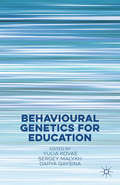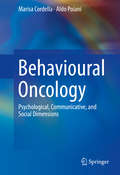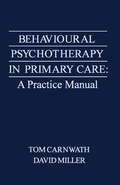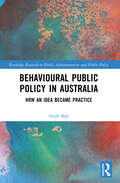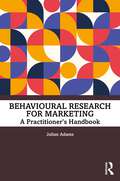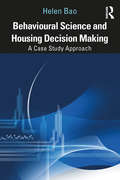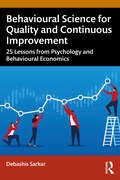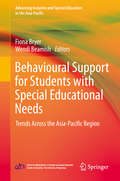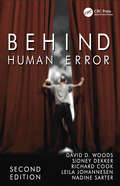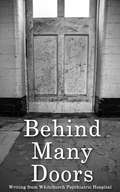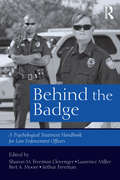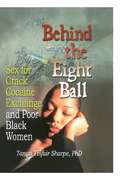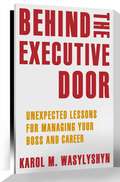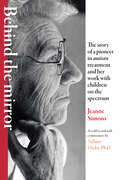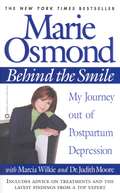- Table View
- List View
Behavioural Economics and Finance
by Michelle BaddeleyBehavioural economics and behavioural finance are rapidly expanding fields that are continually growing in prominence. While orthodox economic models are built upon restrictive and simplifying assumptions about rational choice and efficient markets, behavioural economics offers a robust alternative using insights and evidence that rest more easily with our understanding of how real people think, choose and decide. This insightful textbook introduces the key concepts from this rich, interdisciplinary approach to real-world decision-making. This new edition of Behavioural Economics and Finance is a thorough extension of the first edition, including updates to the key chapters on prospect theory; heuristics and bias; time and planning; sociality and identity; bad habits; personality, moods and emotions; behavioural macroeconomics; and well-being and happiness. It also includes a number of new chapters dedicated to the themes of incentives and motivations, behavioural public policy and emotional trading. Using pedagogical features such as chapter summaries and revision questions to enhance reader engagement, this text successfully blends economic theories with cutting-edge multidisciplinary insights. This second edition will be indispensable to anyone interested in how behavioural economics and finance can inform our understanding of consumers’ and businesses’ decisions and choices. It will appeal especially to undergraduate and graduate students but also to academic researchers, public policy-makers and anyone interested in deepening their understanding of how economics, psychology and sociology interact in driving our everyday decision-making.
Behavioural Economics and Finance (Routledge Advanced Texts In Economics And Finance Ser.)
by Michelle BaddeleyBehavioural economics and behavioural finance are rapidly expanding fields that are continually growing in prominence. While orthodox economic models are built upon restrictive and simplifying assumptions about rational choice and efficient markets, behavioural economics offers a robust alternative using insights and evidence that rest more easily with our understanding of how real people think, choose and decide. This insightful textbook introduces the key concepts from this rich, interdisciplinary approach to real-world decision-making. This new edition of Behavioural Economics and Finance is a thorough extension of the first edition, including updates to the key chapters on prospect theory; heuristics and bias; time and planning; sociality and identity; bad habits; personality, moods and emotions; behavioural macroeconomics; and well-being and happiness. It also includes a number of new chapters dedicated to the themes of incentives and motivations, behavioural public policy and emotional trading. Using pedagogical features such as chapter summaries and revision questions to enhance reader engagement, this text successfully blends economic theories with cutting-edge multidisciplinary insights. This second edition will be indispensable to anyone interested in how behavioural economics and finance can inform our understanding of consumers’ and businesses’ decisions and choices. It will appeal especially to undergraduate and graduate students but also to academic researchers, public policy-makers and anyone interested in deepening their understanding of how economics, psychology and sociology interact in driving our everyday decision-making.
Behavioural Foundations of Economics
by J. BaxterIn recent years, work on what may broadly be described as 'behavioural economics' has expanded rapidly, and is now attracting the attention of leading figures in economics, such as Kenneth Arrow. Much of the work, however, has concentrated on particular aspects of individual and aggregate behaviour. The book attempts to construct a unified framework, showing both how behavioural variables form the basis of economic activity, and how behavioural and economic variables interact to determine individual and aggregate behaviour.
Behavioural Genetics for Education
by Yulia Kovas Sergey Malykh Darya GaysinaEducational environments interact with children's unique genetic profiles, leading to wide individual differences in learning ability, motivation, and achievement in different academic subjects – even when children study with the same teacher, attend the same school and follow the same curriculum. This book considers how education can benefit from the recent progress in genetically informative research. The book provides new insights into the origins of individual differences in education traits such as cognitive abilities and disabilities; motivation and personality; behavioural and emotional problems; social functioning; well-being, and academic achievement. Written and edited by international interdisciplinary experts, this book will be of interest to teachers, parents, educational and developmental psychologists, policy makers and researchers in different fields working on educationally-relevant issues.
Behavioural Oncology: Psychological, Communicative, and Social Dimensions
by Marisa Cordella Aldo PoianiMedical, educational, and public health efforts have reduced the spread of many major diseases, yet cancer perseveres, in spite of continuing research and improvements in practice. Especially promising among therapeutic strategies are ones that recognise patients as individuals with thoughts, feelings--and speech.Rooted in deep understanding of the mutual relationship between behavior and cancer, Behavioural Oncology combines extensive clinical wisdom and empirical data to illuminate the psychological, social, and existential aspects of cancer, and to offer a framework for empathic, patient-centered care. Chapters delve into the psychobiology of long-term illness, examining stress, pain, fatigue, sensory and sleep disturbances, and other quality of life issues as well as considerations of age, gender, culture, and comorbidity. The book's emphasis on linguistic and communicative aspects of cancer--and practical skills from respecting patient narratives to delivering bad news--adds necessary depth to concepts of the therapeutic relationship. In this way, the authors warn about overmedicalizing cases to the point of losing patient identity. Major areas of the coverage include:Biology and behavior in cancer prevention and suppression.The psychology of cancer patients: emotions, cognition, and personalitySocial dimensions, including stigma, coping, and social supportLanguage, communication, and cross-cultural issuesExistential, spiritual, and end-of-life concernsDoctor-patient relationshipsThe psychological benefits of complementary therapiesBringing new scope and substance to familiar mind/body constructs, Behavioural Oncology is a definitive reference for a spectrum of healthcare professionals, among them health and clinical psychologists, oncologists and family physicians, oncology nurses, and clinical social workers. Its discussion questions and summaries make it a suitable text for undergraduate and graduate courses in related topics.
Behavioural Psychotherapy in Primary Care: A Practice Manual
by Tom Carnwath David M. MillerBehavioural Psychotherapy in Primary Care: A Practice Manual describes techniques suitable for treating the majority of problems commonly found in this setting which are amenable to psychological treatment. The book serves as a practice manual, and discusses techniques in behavioral analysis, problem-solving, working with families, skills training, relaxation, exposure, stimulus and reinforcement control, paradoxical prescriptions, and cognitive therapies. The assessment and treatment strategies for depression; phobias and obsessive disorders; anxiety; sexual dysfunction; obesity; alcohol abuse; smoking; and insomnia are considered. The text also describes behavioral medicine; illness behavior; and treatment adherence. Psychotherapists, psychologists, psychiatrists, psychiatric nurses, social workers, health visitors and counselors will find the manual invaluable.
Behavioural Public Policy in Australia: How an Idea Became Practice (Public Administration and Public Policy)
by Sarah BallUsing rich ethnographic data and first-hand experience, Ball presents a detailed account of Australia’s attempts to incorporate behavioural insights into its public policy. Ball identifies three competing interpretations of behavioural public policy, and how these interpretations have influenced the use of this approach in practice. The first sees the process as an opportunity to introduce more rigorous evidence. The second interpretation focuses on increasing compliance, cost savings and cutting red tape. The last focuses on the opportunity to better involve citizens in policy design. These interpretations demonstrate different ‘solutions’ to a series of dilemmas that the Australian Public Service, and others, have confronted in the last 50 years, including growing politicisation, technocracy and a disconnect from the needs of citizens. Ball offers a detailed account of how these priorities have shaped how behavioural insights have been implemented in policy-making, as well as reflecting on the challenges facing policy work more broadly. An essential read for practitioners and scholars of policy-making, especially in Australia.
Behavioural Public Policy in Australia: How an Idea Became Practice (Public Administration and Public Policy)
by Sarah BallUsing rich ethnographic data and first-hand experience, Ball presents a detailed account of Australia’s attempts to incorporate behavioural insights into its public policy. Ball identifies three competing interpretations of behavioural public policy, and how these interpretations have influenced the use of this approach in practice. The first sees the process as an opportunity to introduce more rigorous evidence. The second interpretation focuses on increasing compliance, cost savings and cutting red tape. The last focuses on the opportunity to better involve citizens in policy design. These interpretations demonstrate different ‘solutions’ to a series of dilemmas that the Australian Public Service, and others, have confronted in the last 50 years, including growing politicisation, technocracy and a disconnect from the needs of citizens. Ball offers a detailed account of how these priorities have shaped how behavioural insights have been implemented in policy-making, as well as reflecting on the challenges facing policy work more broadly. An essential read for practitioners and scholars of policy-making, especially in Australia.
Behavioural Research for Marketing: A Practitioner's Handbook
by Julian AdamsThis book, the first of its kind, provides market researchers and marketeers with the tools to better understand human behaviour by drawing upon social science theory from different schools of thought, including sociology, psychology and behavioural economics. It has practical examples throughout to help illustrate how to operationalise theory in market research and to underpin the way we understand how people think, behave, decide and make choices. Each theory is explained in accessible terms to ensure that the content is relevant and useful to commercial market researchers. By considering different theoretical models of human behaviour from the outset, this book will open new avenues of investigation, help researchers to develop more dynamic and challenging hypotheses to test during the research process, and ultimately result in more insightful outcomes. The book brings together theories that look at how society is shaped and formed, and how this impacts on the individual, along with theories that focus on the mind and behaviour of the individual; these perspectives are equally important in market research but not usually considered within the same text. This book is not limited to theory alone; in each chapter, illustrative examples are used to help demonstrate how theory can be applied to real-world market research projects. Additionally, throughout there are helpful suggestions in terms of question content to help operationalise theory. This book will appeal to those that have recently entered the field of market research and are interested in the theoretical underpinnings of human behaviour, undergraduates and post-graduates that are studying marketing, business studies or social science, where a core component of the course requirement is market research, and finally those that are users of market research data and want a working knowledge of key theories of human behaviour.
Behavioural Research for Marketing: A Practitioner's Handbook
by Julian AdamsThis book, the first of its kind, provides market researchers and marketeers with the tools to better understand human behaviour by drawing upon social science theory from different schools of thought, including sociology, psychology and behavioural economics. It has practical examples throughout to help illustrate how to operationalise theory in market research and to underpin the way we understand how people think, behave, decide and make choices. Each theory is explained in accessible terms to ensure that the content is relevant and useful to commercial market researchers. By considering different theoretical models of human behaviour from the outset, this book will open new avenues of investigation, help researchers to develop more dynamic and challenging hypotheses to test during the research process, and ultimately result in more insightful outcomes. The book brings together theories that look at how society is shaped and formed, and how this impacts on the individual, along with theories that focus on the mind and behaviour of the individual; these perspectives are equally important in market research but not usually considered within the same text. This book is not limited to theory alone; in each chapter, illustrative examples are used to help demonstrate how theory can be applied to real-world market research projects. Additionally, throughout there are helpful suggestions in terms of question content to help operationalise theory. This book will appeal to those that have recently entered the field of market research and are interested in the theoretical underpinnings of human behaviour, undergraduates and post-graduates that are studying marketing, business studies or social science, where a core component of the course requirement is market research, and finally those that are users of market research data and want a working knowledge of key theories of human behaviour.
Behavioural Science and Housing Decision Making: A Case Study Approach
by Helen BaoThis book takes a behavioural approach to examine six important housing questions: tenure decision, gentrification, place attachment, housing bubbles, housing wealth, and residential satisfaction. Using experimental and field data, the book demonstrates the effects of six behavioural biases and heuristics (i.e., anchoring and reference dependence, loss aversion, mental accounting, endowment effect, herd behaviours, and social comparison) on these housing decisions. The first part of the book introduces the questions and provides a behavioural science toolbox before the second part adopts a real-world case study approach. Real data sets and suggested answers are provided, and the cases come from the UK, USA, and China. Background information is given in each case to facilitate the understanding of the case data and question, as well as the discussions on the results. This book is ideal supplementary reading on a variety of courses such as housing studies, economics, real estate, research methods, and for students and academics who are interested in the application of behavioural science in housing decisions.
Behavioural Science and Housing Decision Making: A Case Study Approach
by Helen BaoThis book takes a behavioural approach to examine six important housing questions: tenure decision, gentrification, place attachment, housing bubbles, housing wealth, and residential satisfaction. Using experimental and field data, the book demonstrates the effects of six behavioural biases and heuristics (i.e., anchoring and reference dependence, loss aversion, mental accounting, endowment effect, herd behaviours, and social comparison) on these housing decisions. The first part of the book introduces the questions and provides a behavioural science toolbox before the second part adopts a real-world case study approach. Real data sets and suggested answers are provided, and the cases come from the UK, USA, and China. Background information is given in each case to facilitate the understanding of the case data and question, as well as the discussions on the results. This book is ideal supplementary reading on a variety of courses such as housing studies, economics, real estate, research methods, and for students and academics who are interested in the application of behavioural science in housing decisions.
Behavioural Science for Quality and Continuous Improvement: 25 Lessons from Psychology and Behavioural Economics
by Debashis SarkarThis impactful volume demonstrates the application and power of psychology and behavioural economics in the pursuit of quality and continuous improvement. It focusses on how the works of stalwarts such as Daniel Kahneman, Richard Thaler, Mihaly Csikszentmihalyi and many others can be used to build an organization that is known for quality products and flawless service delivery. The application of psychology and behavioral economics is still new to quality improvement, and in this book, Debashis Sarkar shares 25 lessons, featuring specific examples based on real life, that show how their application can increase the effectiveness of outcomes. Behavioural Science for Quality and Continuous Improvement: 25 Lessons from Psychology and Behavioral Economics is ideal for business improvement professionals of all hierarchies and across different functional areas and industries seeking to understand the potential of psychology and behavioural economics and their applications, as well as in training and executive development programmes and for scholars of operations management, quality management, and engineering.
Behavioural Science for Quality and Continuous Improvement: 25 Lessons from Psychology and Behavioural Economics
by Debashis SarkarThis impactful volume demonstrates the application and power of psychology and behavioural economics in the pursuit of quality and continuous improvement. It focusses on how the works of stalwarts such as Daniel Kahneman, Richard Thaler, Mihaly Csikszentmihalyi and many others can be used to build an organization that is known for quality products and flawless service delivery. The application of psychology and behavioral economics is still new to quality improvement, and in this book, Debashis Sarkar shares 25 lessons, featuring specific examples based on real life, that show how their application can increase the effectiveness of outcomes. Behavioural Science for Quality and Continuous Improvement: 25 Lessons from Psychology and Behavioral Economics is ideal for business improvement professionals of all hierarchies and across different functional areas and industries seeking to understand the potential of psychology and behavioural economics and their applications, as well as in training and executive development programmes and for scholars of operations management, quality management, and engineering.
Behavioural Support for Students with Special Educational Needs: Trends Across the Asia-Pacific Region (Advancing Inclusive and Special Education in the Asia-Pacific)
by Fiona Bryer Wendi BeamishThis book reports on the use of behavioural support – an evidence-based approach developed in the USA to meet students’ special educational needs – in Australia and selected thriving Asian countries. It brings together key issues and insights into how educational policy and practices in different societies and cultures influence the uptake of behavioural support in schools and classrooms.The book provides a balanced and highly informative perspective on the historical paths of development and current expansion of behavioural support into regular schools in the USA. It also offers insights into the progress of its implementation outside the Western context of the USA and Europe and its influence on capacity building among professionals within various contexts across the Asia-Pacific region. Case studies from Australia demonstrate the effectiveness of multi-tiered behavioural support in a state government education system for a population of diverse students, and address the resultant adaptation of tiers when it is implemented in a nongovernment school organisation for students with autism. Case studies from Singapore, Mainland China, Hong Kong, South Korea and Japan reveal the cultural practices and organisational issues that produce distinctive characteristics of behavioural support in inclusive and special education within these countries.This book offers essential guidance to educational decision-makers in these countries and communities around diverse students in considering their next steps towards using behavioural supports proposed in the American blueprints for implementing and building capacity for use in any context.
Behind Human Error
by David D. Woods Sidney Dekker Richard Cook Leila Johannesen Nadine SarterHuman error is cited over and over as a cause of incidents and accidents. The result is a widespread perception of a 'human error problem', and solutions are thought to lie in changing the people or their role in the system. For example, we should reduce the human role with more automation, or regiment human behavior by stricter monitoring, rules or procedures. But in practice, things have proved not to be this simple. The label 'human error' is prejudicial and hides much more than it reveals about how a system functions or malfunctions. This book takes you behind the human error label. Divided into five parts, it begins by summarising the most significant research results. Part 2 explores how systems thinking has radically changed our understanding of how accidents occur. Part 3 explains the role of cognitive system factors - bringing knowledge to bear, changing mindset as situations and priorities change, and managing goal conflicts - in operating safely at the sharp end of systems. Part 4 studies how the clumsy use of computer technology can increase the potential for erroneous actions and assessments in many different fields of practice. And Part 5 tells how the hindsight bias always enters into attributions of error, so that what we label human error actually is the result of a social and psychological judgment process by stakeholders in the system in question to focus on only a facet of a set of interacting contributors. If you think you have a human error problem, recognize that the label itself is no explanation and no guide to countermeasures. The potential for constructive change, for progress on safety, lies behind the human error label.
Behind Human Error
by David D. Woods Sidney Dekker Richard Cook Leila Johannesen Nadine SarterHuman error is cited over and over as a cause of incidents and accidents. The result is a widespread perception of a 'human error problem', and solutions are thought to lie in changing the people or their role in the system. For example, we should reduce the human role with more automation, or regiment human behavior by stricter monitoring, rules or procedures. But in practice, things have proved not to be this simple. The label 'human error' is prejudicial and hides much more than it reveals about how a system functions or malfunctions. This book takes you behind the human error label. Divided into five parts, it begins by summarising the most significant research results. Part 2 explores how systems thinking has radically changed our understanding of how accidents occur. Part 3 explains the role of cognitive system factors - bringing knowledge to bear, changing mindset as situations and priorities change, and managing goal conflicts - in operating safely at the sharp end of systems. Part 4 studies how the clumsy use of computer technology can increase the potential for erroneous actions and assessments in many different fields of practice. And Part 5 tells how the hindsight bias always enters into attributions of error, so that what we label human error actually is the result of a social and psychological judgment process by stakeholders in the system in question to focus on only a facet of a set of interacting contributors. If you think you have a human error problem, recognize that the label itself is no explanation and no guide to countermeasures. The potential for constructive change, for progress on safety, lies behind the human error label.
Behind Many Doors
by Phil CarradiceBehind Many Doors is a vivid and revealing portrait of an Edwardian psychiatric hospital in Cardiff, created by those who know it most intimately. Whitchurch Hospital, formerly Cardiff Asylum, will cease to admit in-patients from 2016, marking the beginning of its gradual closure over the following years. This unique anthology seeks to capture, preserve and shine a light on what Whitchurch Hospital has meant and still means to service users, staff, visitors and members of the local community across its long and complex history. Readers are invited to experience the hospital from every angle, from the water tower’s outline spied from the top deck of a Cardiff bus, right down to the cigarette burns on the ward carpet. Sometimes shocking, often moving, always illuminating, this collection of writing will compel all those who turn its pages to think anew about the mental healthcare of the past and the future and to look again at a building that has impacted upon the lives of so many.
Behind the Badge: A Psychological Treatment Handbook for Law Enforcement Officers
by Sharon M. Freeman Clevenger Laurence Miller Bret A. Moore Arthur FreemanThis volume is the logical follow-up to the military treatment handbook: Living and Surviving in Harm’s Way. Sharon Freeman Clevenger, Laurence Miller, Bret Moore, and Arthur Freeman return with this dynamic handbook ideal for law enforcement agencies interested in the psychological health of their officers. Contributors include law enforcement officers with diverse experiences, making this handbook accessible to readers from law enforcement backgrounds. This authoritative, comprehensive, and critical volume on the psychological aspects of police work is a must for anyone affiliated with law enforcement.
Behind the Badge: A Psychological Treatment Handbook for Law Enforcement Officers
by Sharon M. Freeman Clevenger Laurence Miller Bret A. Moore Arthur FreemanThis volume is the logical follow-up to the military treatment handbook: Living and Surviving in Harm’s Way. Sharon Freeman Clevenger, Laurence Miller, Bret Moore, and Arthur Freeman return with this dynamic handbook ideal for law enforcement agencies interested in the psychological health of their officers. Contributors include law enforcement officers with diverse experiences, making this handbook accessible to readers from law enforcement backgrounds. This authoritative, comprehensive, and critical volume on the psychological aspects of police work is a must for anyone affiliated with law enforcement.
Behind the Eight Ball: Sex for Crack Cocaine Exchange and Poor Black Women
by Tanya Telfair SharpeInner-city black women open their hearts to share the pain of crack addiction and its consequences Behind the Eight Ball: Sex for Crack Cocaine Exchange and Poor Black Women documents an American tragedy that highlights the widening gap between social and economic classes. In their own words, poor black women-nameless, faceless, and marginalized by poverty-share the details of their lives before and after crack cocaine invaded their communities, each recalling the circumstances of her introduction to the drug and her first experience using sex to support her addiction. These candid interviews expose the socioeconomic changes in inner-city neighborhoods that created the perfect conditions for a crack stronghold; the crack cocaine economy's impact on the lives of inner-city residents; and the social and familial consequences of crack addiction among poor, black women. Behind the Eight Ball: Sex for Crack Cocaine Exchange and Poor Black Women places crack addiction, crack-related prostitution and its consequences, STDs, HIV, and pregnancy into the context of the larger social issues of inner-city poverty, race, gender, and class. This unique book reveals the sex-for-crack barter system as evidence of a long-term social exclusion and systemic racism that has worked to destroy the self-image of poor black American women. The women interviewed reflect this negative image, exchanging sex for crack on a regular basis to support their addictions at the risk-and reality-of unplanned pregnancies. "The baby I am carrying now, I don&’t know who the father is. There are a few (men) that I had sex with around the time I got pregnant-that day. But which one it is, I don&’t know who."Behind the Eight Ball: Sex for Crack Cocaine Exchange and Poor Black Women examines: why poor black women addicted to crack are disproportionately at risk for sexually transmitted diseases, including HIV, and unplanned pregnancies how the social and economic characteristics of poor black communities support crack distribution and consumption how crack use and the exchange of sex for crack damages struggling black families why the care of many children is entrusted to child welfare agencies how and why women are marginalized in the crack cultureBehind the Eight Ball: Sex for Crack Cocaine Exchange and Poor Black Women is an insightful and enlightening look at the motivations behind the decision to risk illness, injury, disease, death, and pregnancy to support addiction.
Behind the Eight Ball: Sex for Crack Cocaine Exchange and Poor Black Women
by Tanya Telfair SharpeInner-city black women open their hearts to share the pain of crack addiction and its consequences Behind the Eight Ball: Sex for Crack Cocaine Exchange and Poor Black Women documents an American tragedy that highlights the widening gap between social and economic classes. In their own words, poor black women-nameless, faceless, and marginalized by poverty-share the details of their lives before and after crack cocaine invaded their communities, each recalling the circumstances of her introduction to the drug and her first experience using sex to support her addiction. These candid interviews expose the socioeconomic changes in inner-city neighborhoods that created the perfect conditions for a crack stronghold; the crack cocaine economy's impact on the lives of inner-city residents; and the social and familial consequences of crack addiction among poor, black women. Behind the Eight Ball: Sex for Crack Cocaine Exchange and Poor Black Women places crack addiction, crack-related prostitution and its consequences, STDs, HIV, and pregnancy into the context of the larger social issues of inner-city poverty, race, gender, and class. This unique book reveals the sex-for-crack barter system as evidence of a long-term social exclusion and systemic racism that has worked to destroy the self-image of poor black American women. The women interviewed reflect this negative image, exchanging sex for crack on a regular basis to support their addictions at the risk-and reality-of unplanned pregnancies. "The baby I am carrying now, I don&’t know who the father is. There are a few (men) that I had sex with around the time I got pregnant-that day. But which one it is, I don&’t know who."Behind the Eight Ball: Sex for Crack Cocaine Exchange and Poor Black Women examines: why poor black women addicted to crack are disproportionately at risk for sexually transmitted diseases, including HIV, and unplanned pregnancies how the social and economic characteristics of poor black communities support crack distribution and consumption how crack use and the exchange of sex for crack damages struggling black families why the care of many children is entrusted to child welfare agencies how and why women are marginalized in the crack cultureBehind the Eight Ball: Sex for Crack Cocaine Exchange and Poor Black Women is an insightful and enlightening look at the motivations behind the decision to risk illness, injury, disease, death, and pregnancy to support addiction.
Behind the Executive Door: Unexpected Lessons for Managing Your Boss and Career
by Karol M. WasylyshynSigmund Freud meets Peter Drucker … Behind the Executive Door is a revealing look at the behavior of top business leaders—and how the next level of aspiring managers can learn to navigate the political and personal landscape. Based on over 25 years of psychotherapy and consulting experiences, as well as extensive empirical research, Karol Wasylyshyn has identified a dynamic continuum of executive behaviors that are manifested in three specific types of business leaders – Remarkable, Perilous, and Toxic. She describes these types in accessible terms with the intertwined goals of helping readers (1) recognize these behaviors and leadership types and (2) leverage this information to increase their savvy and effectiveness in the workplace. In the wake of Sarbanes-Oxley and the increased scrutiny of business executives, we have learned that how they lead is often their undoing – or at least it is a pressing development need and/or potential derailment factor. In short, despite financial or strategic smarts, ineffective leadership behavior de-motivates talented employees, has adverse effects on productivity, and jeopardizes positive business results. Conversely, we can recognize the qualities of effective leadership behavior, which is largely a function of emotional intelligence, the ability to tap into the needs and motivations of others and bring out their best performance. In Behind the Executive Door, the author provides a wide variety of tools and exercises to help the reader identify the behavior traits of their organizations’ leaders –and hone their own approaches to achieve positive results. In the process, readers will also gain insights and skills to manage laterally and down, as well as up the organizational ladder. The concepts can be applied in any type of organization – private or public, for-profit or non-profit. The result is not only a better understanding of organizational politics and leadership behavior, but a practical guide to making important career decisions, such as whom to work for and how to develop one’s own leadership style.
Behind the Mirror: The Story of a Pioneer in Autism Treatment and Her Work with Children on the Spectrum
by Sabine Oishi Jeanne SimonsThe life story of Jeanne Simons, whose own autism informed her pioneering work with autistic children.Jeanne Simons devoted her career as a social worker and educator to the study, treatment, and care of children with autism. In 1955, she established the Linwood Children's Center in Ellicott City, Maryland, one of the first schools dedicated to children with autism. Her Linwood Model, developed there, was widely adopted and still forms the basis for a variety of autism intervention techniques. Incredibly—although unknown at the time—Jeanne was herself autistic. Behind the Mirror reveals the remarkable tale of this trailblazer and how she thought, felt, and experienced the world around her. With moving immediacy, Jeanne tells her life story to developmental psychologist, friend, and collaborator Sabine Oishi. Jeanne's unique experience is supplemented by commentary from Dr. Oishi, who explains the importance of key biographical details and fills in additional information about the diagnosis and treatment of autism. Enhanced with a photo gallery, a look at new approaches to the education of children with autism, and a history of Linwood since its founding, the book also contains a foreword, an afterword, and an appendix by James C. Harris, MD, the past director of child psychiatry at Johns Hopkins University School of Medicine and the founder of its autism clinic. Demystifying the experience of autism, Behind the Mirror is a groundbreaking account of possibilities and hope.
Behind the Smile: My Journey out of Postpartum Depression
by Marie Osmond Marcia Wilkie Dr. Judith MooreMore than one out of 10 new mothers experience post-partum depression (PPD), yet few women seek help. After Marie Osmond, beloved singer and TV talk show host, gave birth to her seventh child (four of her children are adopted), she became increasingly depressed. One night, she handed over her bank card to her babysitter, got in her car, and drove north-with no intention of returning until she had emerged from her crisis. After she went public with her own experiences with PPD on Oprah and Larry King Live, the response was overwhelming. Now collaborating with a doctor who helped her through her ordeal, Marie Osmond will share the fear and depression she overcame, and reveal how she put it all behind her and is moving on with her life.
